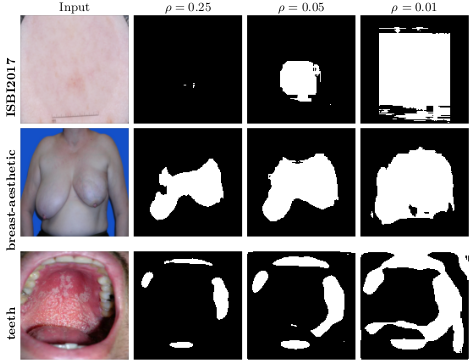Traditionally, the trade-off between false positive and false negatives is specified in terms of relative costs using a cost matrix. But it might be more natural in some contexts to apply this trade-off in terms of an absolute cost: for example, we want to minimize false negatives while keeping false positives below a certain threshold ρ.
Example of what happens has this threshold is changed:
This work is the implementation used in the paper:
- Averse Deep Semantic Segmentation. Cruz et al. 41st Engineering in Medicine and Biology Conference. (2019)
This paper is an extension for image segmentation, based on our previous work on averse classifiers, which are applied to tabular data:
- Constraining Type II Error: Building Intentionally Biased Classifiers. Cruz et al. 14th International Work-Conference on Artificial Neural Networks. LNCS Springer. (2017)
Run "python3 run.py [OPTIONS]" where OPTIONS are some of the definitions to be used to train the model. The most important follow. Please consult run.py for the full list.
--datasetchoose one of the datasets, loaded from mydataset.py (mandatory)--modelchoose one of the models, created on mymodel.py (mandatory)--depthdepth of each encoding/decoder part of the model (default: 2)--rhothe amount of false negatives to tolerate--term [squared/relu_squared/entropy/old]the A-terms from the paper--pingpongthe ping-pong method from the paper--warmupthe warmup method from the paper
